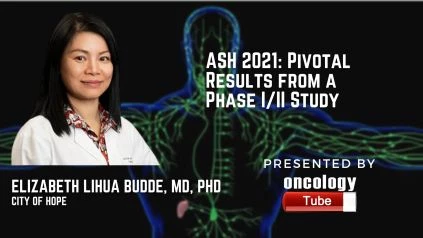Elizabeth Lihua Budde, MD, Ph.D. Associate Professor, Division of Lymphoma, Department of Hematology and; Hematopoietic Cell Transplantation at the City of Hope speaks about the ASH 2021 Abstract 127 Mosunetuzumab Monotherapy Is an Effective and Well-Tolerated Treatment Option for Patients with Relapsed/Refractory (R/R) Follicular Lymphoma (FL) Who Have Received ≥2 Prior Lines of Therapy: Pivotal Results from a Phase I/II Study.
Link to Abstract:
https://ash.confex.com/ash/2021/webprogram/Paper145872.html
Background:
With each course of conventional therapy, FL is linked to more relapses and shorter progression-free intervals. Due to refractory disease, later-line therapies may be less successful. Mosunetuzumab (Mosun) is a bispecific CD20xCD3 antibody (Ab) that drives T lymphocytes to kill cancerous B cells. Mosun was extremely active and well tolerated in R/R FL patients (pts) who had had 2 prior lines of therapy (3L+ R/R FL) when given IV with Cycle (C) 1 step-up dosing for mitigation of cytokine release syndrome in the dose-escalation phase of an ongoing Phase I/II research (NCT02500407) (CRS; Assouline et al. ASH 2020). We describe key findings from a large expansion cohort of 3L+ R/R FL patients who received Mosun monotherapy at the recommended Phase II dose (1/2/60/30mg) in the same study.
Methods:
3L+ R/R FL pts were enrolled in a crucial expansion cohort with a single arm. FL (Grade [Gr] 1–3a), ECOG PS 1, and R/R to 2 prior lines of therapy, including an anti (a)-CD20 Ab and an alkylator, were all present. Mosun was administered intravenously in 21-day cycles, with step-up dose in C1 (C1 Day [D]1: 1 mg; C1D8: 2 mg; C1D15 and C2D1: 60 mg; D1 C3+: 30 mg). Patients who obtained a complete response (CR) by C8 stopped treatment; those who achieved a partial response or had stable disease maintained treatment for a total of 17 cycles, unless disease progression (PD) or unacceptable toxicity occurred. The primary outcome was the PET/CT CR (as best response) rate, which was assessed using conventional response criteria by an independent review facility (IRF) (Cheson et al. J Clin Oncol 2007). There was no requirement for hospitalization.
Results:
A total of 90 participants (median age: 60 years, range: 29–90; 61.1 percent male) were enrolled. 76.7 percent had stage III or IV diseases at the time of admittance, and 44.4 percent had FLIPI 3–5. The average number of previous lines of therapy was three (range: two to ten). Prior cancer therapy comprised anthracyclines (82.2%), ASCT (21.1%), PI3K inhibitors (18.9%), IMiDs (14.4%), BTK inhibitors (6.7%), and CAR-Ts (6.7%), in addition to aCD20 Abs and alkylators (all pts) (3.3 percent ). 68.9% of patients were resistant to their previous therapy, 78.9% to any prior aCD20 antibody, and 53.3 percent to any prior aCD20 antibody with an alkylator (double refractory). Within 24 months of starting treatment, 52.2 percent of patients developed Parkinson’s disease (POD24).
The median time on study was 12.9 months as of March 15, 2021. The majority of patients showed anti-tumor activity. IRF’s best objective response (ORR) and critical response (CR) rates were 78.9% (71/90 pts) and 57.8% (52/90), respectively, with a median time to first response of 1.4 months. Pre-specified subgroups, such as POD24 (ORR: 83 percent; CR: 55 percent) and double-refractory pts, had the best ORR and CR rates (ORR: 69 percent; CR: 48 percent ). The 12-month event-free rates after initial response were 65.4 percent (95 percent CI: 52.6–78.1 percent) in all responders and 80.1 percent (95 percent CI: 67.4–92.7 percent) in CR pts; the median duration of objective response and CR was not obtained. PFS was 17.9 months on average (95 percent confidence interval: 12.0–not estimable).
The most common adverse event was CRS (Lee et al. Biol Blood Marrow Transplant 2019). (AE; 44.4 percent of pts). CRS was primarily restricted to C1 and had a low Gr (Gr 1: 25.6 percent; Gr 2: 16.7 percent ). High-grade CRS was infrequent (Gr 3: 1 patient; Gr 4: 1 patient with FL in the leukemic phase); there was no Gr 5 CRS. Tocilizumab was administered in 7 of the 40 patients with CRS, and corticosteroids were given in 9 of them; all episodes resolved within a median of 3 days. Fatigue (36.7 percent), headache (31.1 percent), neutropenia and pyrexia (both 28.9 percent), hypophosphatemia (22.2 percent), and pruritus (all 20 percent) (21.1 percent ). Neutropenia (26.6 percent), hypophosphatemia (13.3 percent), hyperglycemia and anemia (7.8% each), and increased ALT were the most common Gr 3–4 AEs (5 percent) (5.6 percent ). Gr 3 neurologic episodes were uncommon (4.4%), and there were no Gr 4–5 incidents. CRS (23.3 percent, including 2.2 percent Gr 3–4 CRS) was a common (5 percent) SAE (45.6 percent total). There were two Grade 5 (fatal) AEs (malignant neoplasm progression and unexplained death; both considered unrelated to Mosun by investigators). Mosun was rarely discontinued because to adverse events (4 pts; 4.4 percent ).
Conclusions:
Mosun causes deep and long-lasting remissions in 3L+ R/R FL patients, even those with POD24 and/or double-refractory illness. In the majority of patients, high response rates (ORR: 78.9%; CR: 57.8%) are attained and maintained for 12 months. Mosun has a tolerable safety profile, with a C1 step-up dose effectively reducing CRS and allowing therapy to be completed without the need for hospitalization. Mosun is a promising new treatment option for 3L+ R/R FL.

